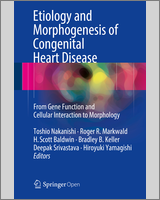Open Access This chapter is distributed under the terms of the Creative Commons Attribution-Noncommercial 2.5 License (http://creativecommons.org/licenses/by-nc/2.5/), which permits any noncommercial use, distribution, and reproduction in any medium, provided the original author(s) and source are credited. The images or other third party material in this chapter are included in the work's Creative Commons license, unless indicated otherwise in the credit line; if such material is not included in the work's Creative Commons license and the respective action is not permitted by statutory regulation, users will need to obtain permission from the license holder to duplicate, adapt or reproduce the material.
NCBI Bookshelf. A service of the National Library of Medicine, National Institutes of Health.
Nakanishi T, Markwald RR, Baldwin HS, et al., editors. Etiology and Morphogenesis of Congenital Heart Disease: From Gene Function and Cellular Interaction to Morphology [Internet]. Tokyo: Springer; 2016. doi: 10.1007/978-4-431-54628-3_33

Etiology and Morphogenesis of Congenital Heart Disease: From Gene Function and Cellular Interaction to Morphology [Internet].
Show detailsKawasaki disease is the most common acute systemic vasculitis of unknown etiology in children [1] and can cause inflammation of the coronary arteries leading to aneurysms. Tenascin-C, an extracellular matrix protein, and c-Jun N-terminal kinase (JNK), an intracellular signaling protein, are known to be associated with inflammation and tissue remodeling [2, 3]. The purpose of this study was to demonstrate tenascin-C and JNK might be involved in tissue remodeling in a Candida albicans-induced murine model of aneurysm.
Keywords:
Kawasaki disease, Tenascin-C, c-Jun N-terminal kinase, Aneurysm, RemodelingKawasaki disease is the most common acute systemic vasculitis of unknown etiology in children [1] and can cause inflammation of the coronary arteries leading to aneurysms. Tenascin-C, an extracellular matrix protein, and c-Jun N-terminal kinase (JNK), an intracellular signaling protein, are known to be associated with inflammation and tissue remodeling [2, 3]. The purpose of this study was to demonstrate tenascin-C and JNK might be involved in tissue remodeling in a Candida albicans-induced murine model of aneurysm.
- 1.
More than 80 % of the mice showed the macroscopic features of aneurysms in the aorta and/or iliac and coronary arteries.
- 2.
Marked inflammatory cell infiltration was observed in vascular wall and perivascular connective tissue, accompanied by fragmentation of elastic fibers.
- 3.
Expression of tenascin-C was highly observed in vascular wall, accompanied by active degradation of elastic fibers.
- 4.
Pharmacologic inhibition of JNK attenuated the aneurysm formation in the mice model.
In conclusion, these findings suggest that both tenascin-C and JNK are involved in abnormal tissue remodeling and inflammation in the Candida albicans-induced Kawasaki disease murine model of aneurysm and that JNK inhibition may represent a novel therapeutic target for preventing a Kawasaki disease-related aneurysm.
References
- 1.
- Kawasaki T, Kosaki F, Okawa S, Shigematsu I, Yanagawa H. A new infantile acute febrile mucocutaneous lymph node syndrome (MLNS) prevailing in Japan. Pediatrics. 1974;54:271–6. [PubMed: 4153258]
- 2.
- Imanaka-Yoshida K. Tenascin-C in cardiovascular tissue remodeling: from development to inflammation and repair. Circ J. 2012;76:2513–20. [PubMed: 23064399] [CrossRef]
- 3.
- Yoshimura K, Aoki H, Ikeda Y, Fujii K, Akiyama N, Furutani A, Hoshii Y, Tanaka N, Ricci R, Ishihara T, Esato K, Hamano K, Matsuzaki M. Regression of abdominal aortic aneurysm by inhibition of c-Jun N-terminal kinase. Nat Med. 2005;11:1330–8. [PubMed: 16311603] [CrossRef]
- JNK is critical for the development of Candida albicans-induced vascular lesions in a mouse model of Kawasaki disease.[Cardiovasc Pathol. 2015]JNK is critical for the development of Candida albicans-induced vascular lesions in a mouse model of Kawasaki disease.Yoshikane Y, Koga M, Imanaka-Yoshida K, Cho T, Yamamoto Y, Yoshida T, Hashimoto J, Hirose S, Yoshimura K. Cardiovasc Pathol. 2015 Jan-Feb; 24(1):33-40. Epub 2014 Aug 28.
- Histopathological features of murine systemic vasculitis caused by Candida albicans extract--an animal model of Kawasaki disease.[Inflamm Res. 2004]Histopathological features of murine systemic vasculitis caused by Candida albicans extract--an animal model of Kawasaki disease.Takahashi K, Oharaseki T, Wakayama M, Yokouchi Y, Naoe S, Murata H. Inflamm Res. 2004 Feb; 53(2):72-7. Epub 2004 Jan 26.
- Review Role of TGF-β Signaling in Remodeling of Noncoronary Artery Aneurysms in Kawasaki Disease.[Pediatr Dev Pathol. 2015]Review Role of TGF-β Signaling in Remodeling of Noncoronary Artery Aneurysms in Kawasaki Disease.Lee AM, Shimizu C, Oharaseki T, Takahashi K, Daniels LB, Kahn A, Adamson R, Dembitsky W, Gordon JB, Burns JC. Pediatr Dev Pathol. 2015 Jul-Aug; 18(4):310-7. Epub 2015 Apr 9.
- Systemic arterial expression of matrix metalloproteinases 2 and 9 in acute Kawasaki disease.[Arterioscler Thromb Vasc Biol....]Systemic arterial expression of matrix metalloproteinases 2 and 9 in acute Kawasaki disease.Gavin PJ, Crawford SE, Shulman ST, Garcia FL, Rowley AH. Arterioscler Thromb Vasc Biol. 2003 Apr 1; 23(4):576-81. Epub 2003 Mar 6.
- Review Management of Kawasaki disease in adults.[Heart. 2017]Review Management of Kawasaki disease in adults.Denby KJ, Clark DE, Markham LW. Heart. 2017 Nov; 103(22):1760-1769. Epub 2017 Jul 27.
- Tissue Remodeling in Vascular Wall in Kawasaki Disease-Related Vasculitis Model ...Tissue Remodeling in Vascular Wall in Kawasaki Disease-Related Vasculitis Model Mice - Etiology and Morphogenesis of Congenital Heart Disease
- KCNG4, partial [synthetic construct]KCNG4, partial [synthetic construct]gi|649145154|gb|AIC61117.1|Protein
- BioProjects for Gene (Select 23038) (4)BioProject
- SFH5 Sfh5p [Saccharomyces cerevisiae S288C]SFH5 Sfh5p [Saccharomyces cerevisiae S288C]Gene ID:853296Gene
- Gene Links for GEO Profiles (Select 30555163) (1)Gene
Your browsing activity is empty.
Activity recording is turned off.
See more...
 1
1